Tucker Sno-Cat
The Tucker Sno-Cat is a family of tracked vehicles for snow conditions, manufactured in Medford, Oregon by the company of the same name.
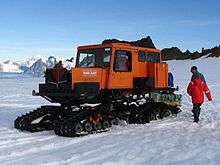
Different models have been used for expeditions in the Arctic and the Antarctic during the second half of the 20th century. It differs from other truck-sized snow vehicles, commonly known as snowcats, by its use of four independently mounted sets of tracks.
Early models
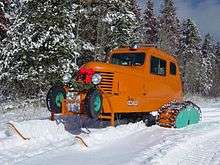
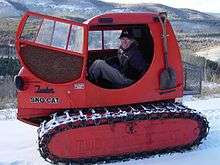
While the majority of Tucker Sno-Cats utilized four sets of tracks, a few experimental models and early production models used two sets of tracks. Initially Tucker Sno-Cats employed two front-mounted steering skis and two sets of tracks mounted to the rear. However, there are at least three production models that only employed dual tracks—the small 222 Tucker Kitten, the 322, and the 323 models were all two-track Tucker Sno-Cats with a conventional front engine design. There are at least two variants of the Tucker Kitten, some have square corner doors while others have rounded corner doors. The Kitten was powered by a 10 hp engine. Additionally there was at least one prototype featuring two tracks and a mid-engine design.
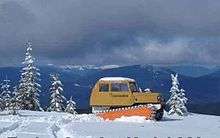
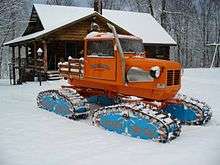
The more common four track Tucker Sno-Cats are considered to be the classic Sno-Cats in American history and have been used extensively in both polar regions for exploration, as well as for transportation, trail grooming and industrial applications. The body style could be configured in many ways and sedan styles, enclosed cargo styles and open bed configurations were all available. Model numbers designated the configuration of the unit, for example a Model 342 was a "300" series, four-track, two-door Tucker Sno-Cat. A Model 443 would be a "400" series, four-track, three-door unit. In the early models, there were ultimately series 200 through 900, with the higher numbers being larger units. The 500 series Tuckers employed extra wide tracks which allowed them to carry heavy loads in very deep soft snow conditions. The early model Tucker Sno-Cats all utilized a unique steel track that revolved around a steel pontoon, the steel pontoons were eventually replaced by fiberglass pontoons. As the models evolved, the steel tracks were replaced with a suspension system that employed rubber belts that were carried by a series of small wheels. Fastened to the exterior of the rubber belts are cleats, also called grousers, made of metal, to offer traction on the snow.
Historical competitors
While Tucker is still in business, its early competitors have not fared well in the face of competition. Other notable players in the North American snowcat market included Thiokol, Bombardier, KRISTI snowcat and Swedish manufacturer Aktiv Snow Trac. All the historical competitors to Tucker Sno-Cat made two-track snowcats.
Thiokol of Utah sold its ski-lift and snowcat operations in 1978, with John Z DeLorean purchasing the snowcat division, and changed its name to DMC. DMC later was bought out by its management team and renamed Logan Machine Company more commonly known as LMC. LMC ceased production in 2000. Thiokol's Imp, Super-Imp and Spryte were most its popular products were continued by DMC and LMC and were commercial successes but could not support the entire company. Many of these models are still in use today in the commercial market and are popular as privately owned snowcats.
KRISTI snowcat had a limited production of 2 track snowcats between 1956 and 1968 in Colorado, it was purchased by a group of Boeing engineers and moved to Washington where it ceased production in the early 1970s with a total production reported to be less than 180 units. Aktiv Snow Trac ceased production in 1982 when its engine supplier (Volkswagen) ceased production of its air-cooled engines in Europe. A majority of the more than 2,200 Snow Tracs made were imported to Canada and the United States, mostly by Canadian utilities and U.S. governmental agencies; the Snow Trac is still in common use in private ownership and to a lesser degree in commerce.
Bombardier still continues in business but has radically altered its business model and product selection. Bombardier sold over 3,000 of its popular snow bus models which are still in use today and in popular demand by dedicated collectors.
Track design evolution
 Original steel tracks
Original steel tracks Belted tracks
Belted tracks Modern Terra track
Modern Terra track
Tucker Sno-Cats were originally built with a steel track that rotates around a steel pontoon. Located at the top center of the pontoon is a drive sprocket with teeth that drive the chain-like tracks around the steel pontoon. Due to maintenance issues with rust on the steel pontoons, fiberglass pontoons eventually replaced some steel parts but the overall mechanism was basically unchanged.
Steel tracks revolving around pontoons were replaced with a system that employed two rubber belts with metal cleats, or grousers, attached to the outside perimeter to grip the snow. A series of wheels and guides were used inside the belts. Two drive sprockets on a hub drive the rubber belted track. The most modern version of the Sno-Cat track is the all-rubber Terra Track system. This system uses a wide single rubber belt, constructed with a multi-ply design similar to a modern car tire. The exterior perimeter employs molded rubber treads instead of the steel grousers of prior models.
Modern competitors and uses
The Tucker Sno-Cat has many modern competitors fighting for the grooming business at ski-resorts and snowmobile clubs as trail groomers.,[1] Kässbohrer Geländefahrzeug/Pisten Bully, VMC/UTV International, Scot-Trac as well as Sure Trac[2] agricultural tractor conversions for snow grooming. Tucker Sno-Cats also builds machines for passenger transport in Arctic regions. The Sno-Cat product range also includes industrial machines for many industries, including fire suppression, drilling and crane operations.
Antarctic exploration
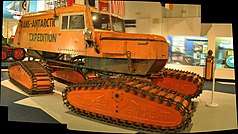
English explorer Sir Vivian Fuchs championed the first Trans-Antarctic expedition and utilized 4 specially prepared Tucker Sno-Cats. Tucker Sno-Cats are still considered a premier extreme condition vehicle and are still in use in both the Arctic and Antarctic regions. A Tucker Sno-Cat 743 was returned to the UK and is currently displayed in the Science Museum at Wroughton, and is currently only viewable via appointment at this location.[3] Another of the same expedition's Sno-Cats is on display in the Antarctic section of the Canterbury Museum in Christchurch, New Zealand. A third is on display at the Antique Gas and Steam Engine Museum in Vista, California, United States.
See also
References
External links
- Sno-Cat corporate and history site.
- Sno-Cat Dealer
- British TV Show "Salvage Squad" Restoration of an Aktiv Snow Trac ST
- Classic Sno-Cat History Page of a Tucker Collector
- Tucker Sno-Cat restoration project page
- Emit Tucker Patent patent list